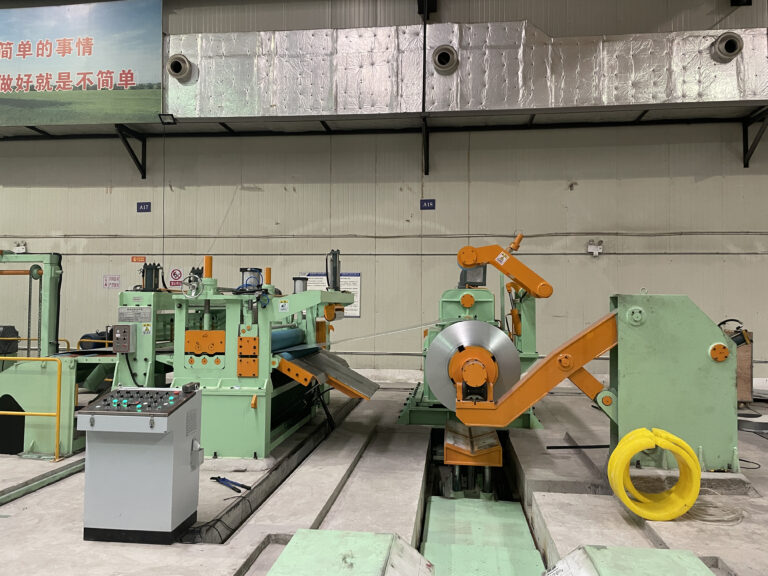Top 10 Coil Processing Equipment Suppliers 2025
The Hidden Complexity of Coil Processing Dynamics
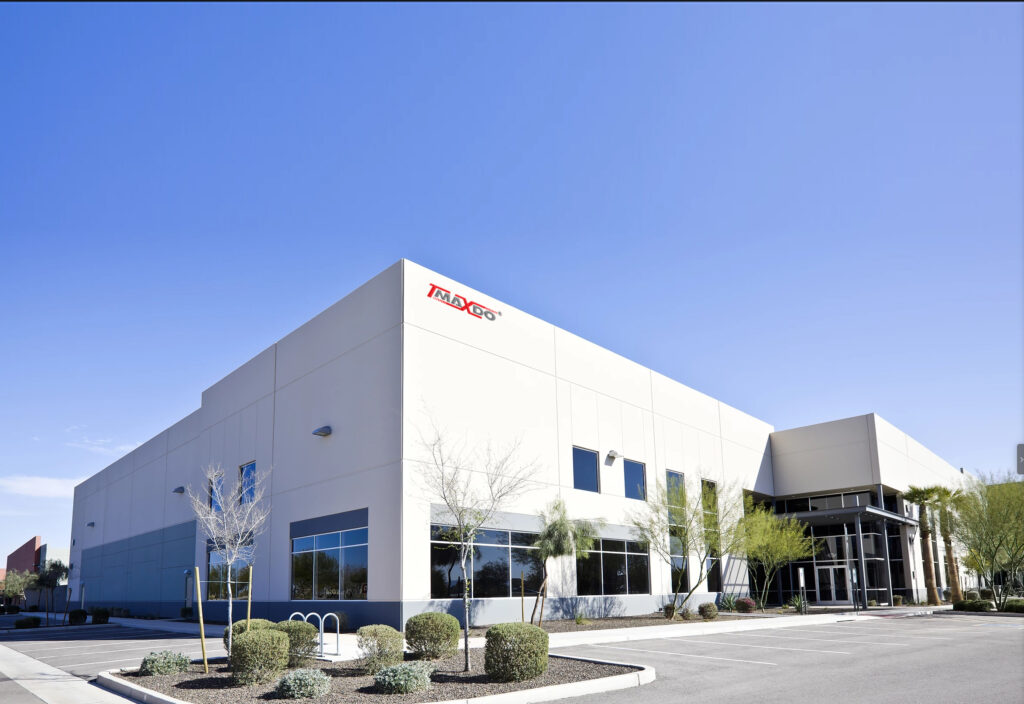
Coil processing in 2025 stands at the intersection of advanced material science and next-generation industrial automation, where seemingly simple operations such as unwinding, leveling, and rewinding steel or aluminum coils mask an intricate web of highly dynamic engineering challenges. Modern coil processing equipment must expertly negotiate rapidly changing tension profiles as coil diameters shrink during production, while accounting for material heterogeneity from outer environmental exposure to core compression.
For instance, in high-demand industries like automotive and aerospace, manufacturers utilize equipment capable of precisely handling coils up to 2150mm wide and weights exceeding 25 tons, with production speeds surpassing 250 meters per minute, demonstrating unprecedented efficiency and precision. Unlike conventional machines, the latest systems leverage servo-driven tension control, real-time IoT-enabled monitoring, and adaptive algorithms to dynamically adjust processing parameters, minimizing material waste and compensating for work hardening and thermal variations in alloys. This evolution transcends mere mechanization—transforming coil processing into a sophisticated discipline that integrates precision engineering, state-of-the-art digital controls, and sustainability-driven design principles, all of which are embodied in MaxDo’s cutting-edge machinery solutions that have reshaped global manufacturing standards through over two decades of innovation and service excellence.
The Engineering Science of Coil Processing Technologies
Decoiling Dynamics: Managing Rotational Inertia and Tension Distribution
Decoiling systems must overcome fundamental physics challenges that intensify as coil diameter changes. The rotational inertia of a coil varies with the fourth power of diameter, meaning that a coil’s resistance to acceleration changes dramatically as it unwinds. A 1800mm diameter coil has 81 times more rotational inertia than the same coil at 600mm diameter, requiring sophisticated control algorithms to maintain consistent material feed rates.
The tension distribution across the material width presents another critical challenge. Wide materials (over 1500mm) can exhibit tension variations of 10-15% across the width due to coil winding irregularities, material property variations, and thermal effects. Advanced decoiling systems use multiple tension measurement points and individual zone control to maintain uniform tension distribution.
Material memory effects further complicate decoiling operations. Steel coils stored for extended periods develop “coil set”—permanent curvature that must be overcome during unwinding. The force required to straighten this curvature varies with material grade, thickness, storage time, and environmental conditions, requiring adaptive control systems that can adjust to changing material behavior.
Slitting Mechanics: Controlled Fracture and Edge Quality
Slitting operations involve creating controlled fractures through material thickness while managing the complex stress fields that develop around cutting tools. The cutting mechanism varies significantly between rotary, shear, and razor slitting, each creating different stress distributions and edge characteristics.
Rotary slitting uses circular knives that create both shearing and tearing actions as they penetrate the material. The cutting forces generate heat that can affect material properties near the cut edge, while knife wear patterns influence edge quality and dimensional accuracy. Advanced systems monitor cutting forces in real-time and adjust knife overlap to compensate for wear effects.
Shear slitting creates controlled fractures through opposing blade action, requiring precise clearance control to achieve optimal edge quality. The blade clearance (typically 5-12% of material thickness) critically affects cutting forces, edge quality, and tool life. Too little clearance causes excessive forces and rapid wear, while too much clearance creates poor edge quality and burr formation.
Leveling Theory: Stress Relief Through Controlled Plastic Deformation
Leveling systems use the principle of controlled plastic deformation to relieve internal stresses and correct shape defects. The process involves bending the material beyond its elastic limit in alternating directions, effectively “erasing” the stress memory that causes shape problems.
The leveling effectiveness depends on the relationship between applied strain and stress relief. Different materials require different strain levels—high-strength steels may need 2-3% strain for effective leveling, while aluminum alloys might require only 1-1.5%. The challenge lies in applying uniform strain across the material width while accommodating thickness and property variations.
Multi-roll levelers use mathematical models based on beam theory to predict optimal roll penetration settings. These models consider material properties, incoming shape conditions, and desired flatness specifications to calculate the required work roll positions. Advanced systems incorporate feedback from flatness measurement devices to continuously optimize leveling parameters.
Recoiling Challenges: Tension Control and Coil Quality
Recoiling operations must manage the reverse of decoiling challenges while maintaining coil quality for subsequent processing or shipping. The tension control during recoiling affects coil density, shape retention, and unwinding characteristics for end users.
Excessive recoiling tension can cause material yielding, edge damage, or telescoping (uneven coil edges), while insufficient tension results in loose coils that may collapse during handling. The optimal tension varies with material properties, coil diameter, and environmental conditions, requiring sophisticated control algorithms that adapt to changing conditions.
Integration and System-Level Optimization
Modern coil processing lines integrate multiple operations under coordinated control, requiring system-level optimization that considers the interactions between different processing stages. Tension variations in the decoiling section affect slitting quality, while leveling forces influence recoiling tension requirements.
Advanced systems use predictive control algorithms that anticipate downstream requirements and adjust upstream operations accordingly. This approach minimizes material waste, reduces quality variations, and optimizes overall line efficiency.
Regional Technology Adoption Patterns
Asia-Pacific: Scale and Integration Focus
Asian manufacturers have emphasized high-capacity, integrated processing lines that can handle large volumes efficiently. The focus has been on developing systems that can process multiple material grades and thicknesses with minimal changeover time. Chinese manufacturers have particularly excelled in creating cost-effective solutions for high-volume applications.
Europe: Precision and Sustainability
European equipment suppliers have concentrated on precision, energy efficiency, and advanced automation. The emphasis on environmental compliance has driven innovations in energy recovery systems, noise reduction, and material waste minimization. German and Italian manufacturers lead in precision leveling and high-speed slitting technologies.
North America: Advanced Control and Flexibility
North American suppliers focus on advanced control systems, predictive maintenance capabilities, and flexible manufacturing solutions. The emphasis on quick changeover and multi-product capability reflects the diverse manufacturing requirements of the regional market.
Top 10 Coil Processing Equipment Suppliers
1. Max Domachine (FOSHAN MAXDO SUPPLY CHAIN MGT CO., LTD.)
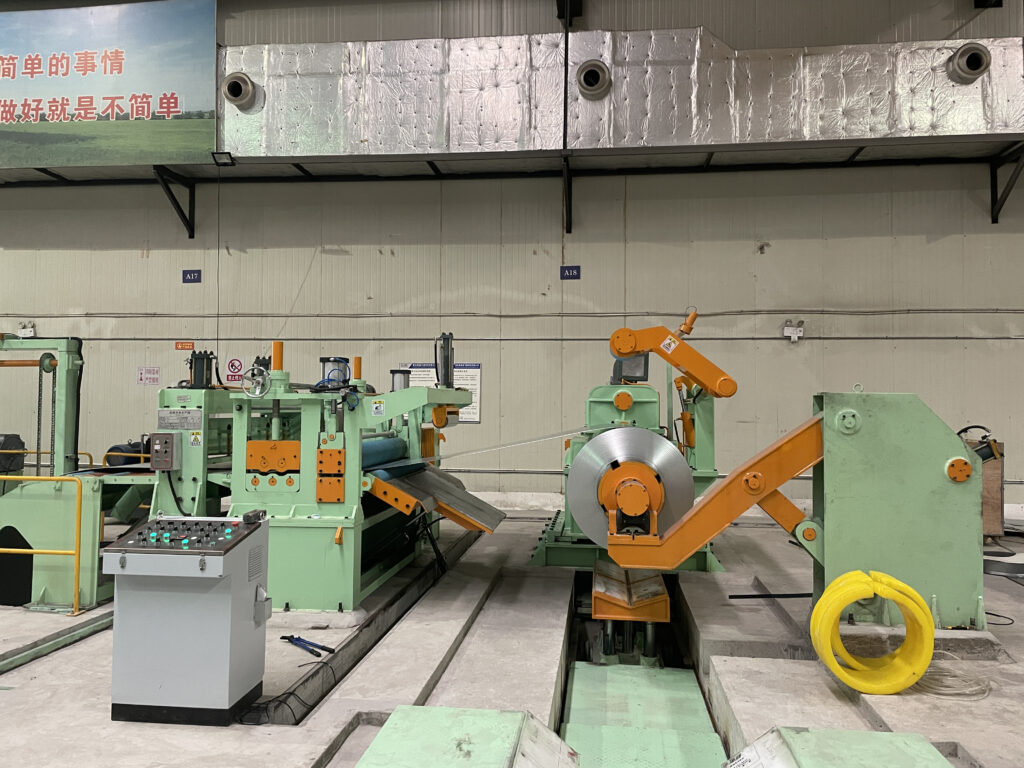
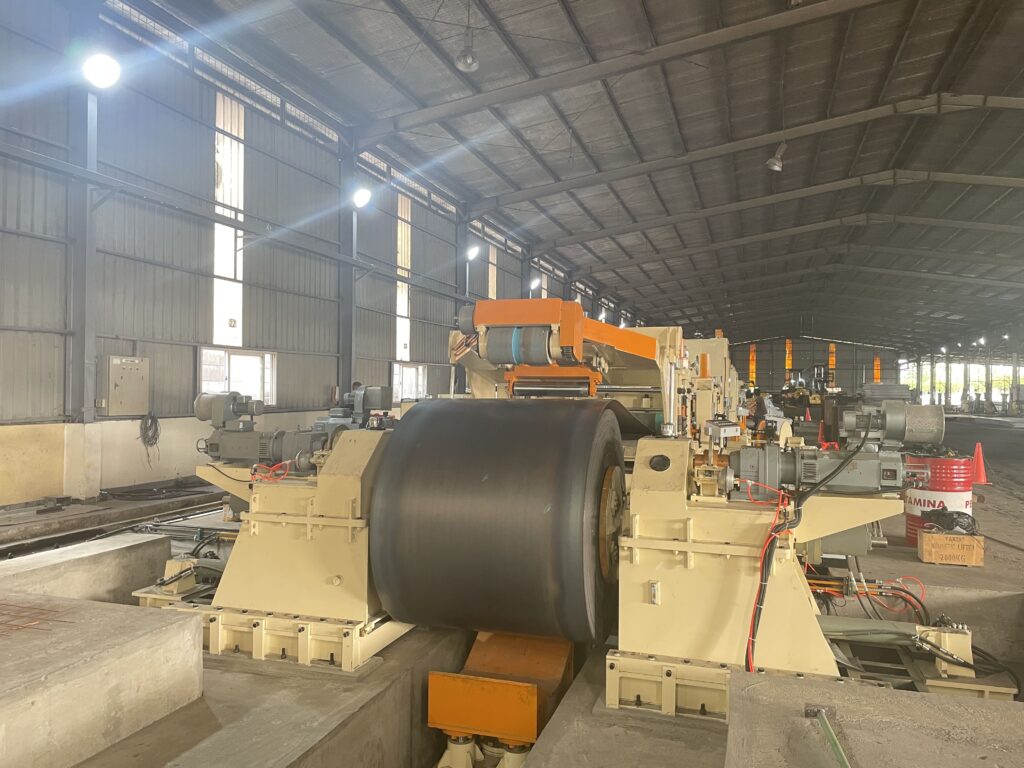
Headquarters: Foshan City, China
Specialization: Integrated coil processing lines with emphasis on modular design and automation
Market Focus: Mid-to-large scale manufacturers requiring flexible processing capabilities
Technical Approach and System Design
Max Domachine’s approach to coil processing centers on modular system design that provides flexibility for different material requirements and production volumes. Their equipment design emphasizes practical functionality and cost-effectiveness rather than cutting-edge technology, making it suitable for manufacturers with standard processing requirements.
Decoiling Technology Implementation
The company’s hydraulic decoiling systems use conventional servo-driven tension control with basic feedback from load cells. While adequate for most applications, the tension control response time and accuracy may not match the performance of specialized high-end systems used in demanding applications.
Slitting Technology Application
Max Domachine’s slitting systems employ standard rotary knife technology with servo positioning for width adjustment. The systems achieve width tolerances typically in the ±0.2-0.3mm range, which is suitable for many industrial applications but may not meet requirements for high-precision industries requiring ±0.1mm accuracy.
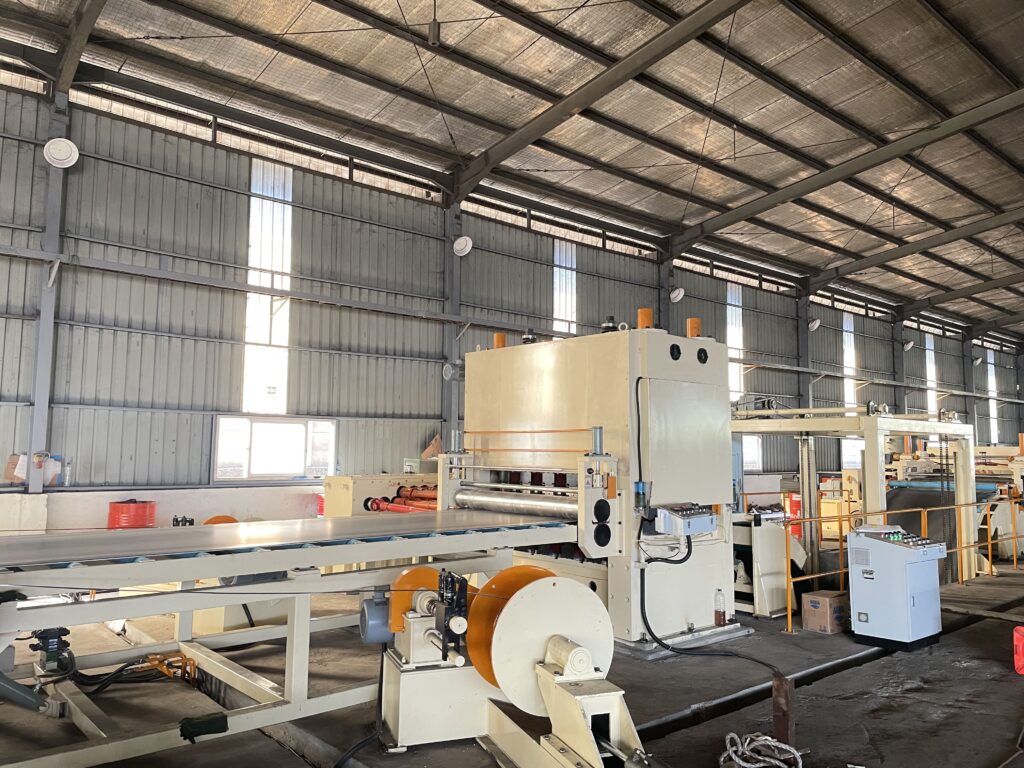
Leveling System Configuration
The 15-roller leveling system uses individually adjustable work rolls with basic position feedback. While capable of improving material flatness, the system may require manual adjustment and operator experience to achieve optimal results across different material conditions.
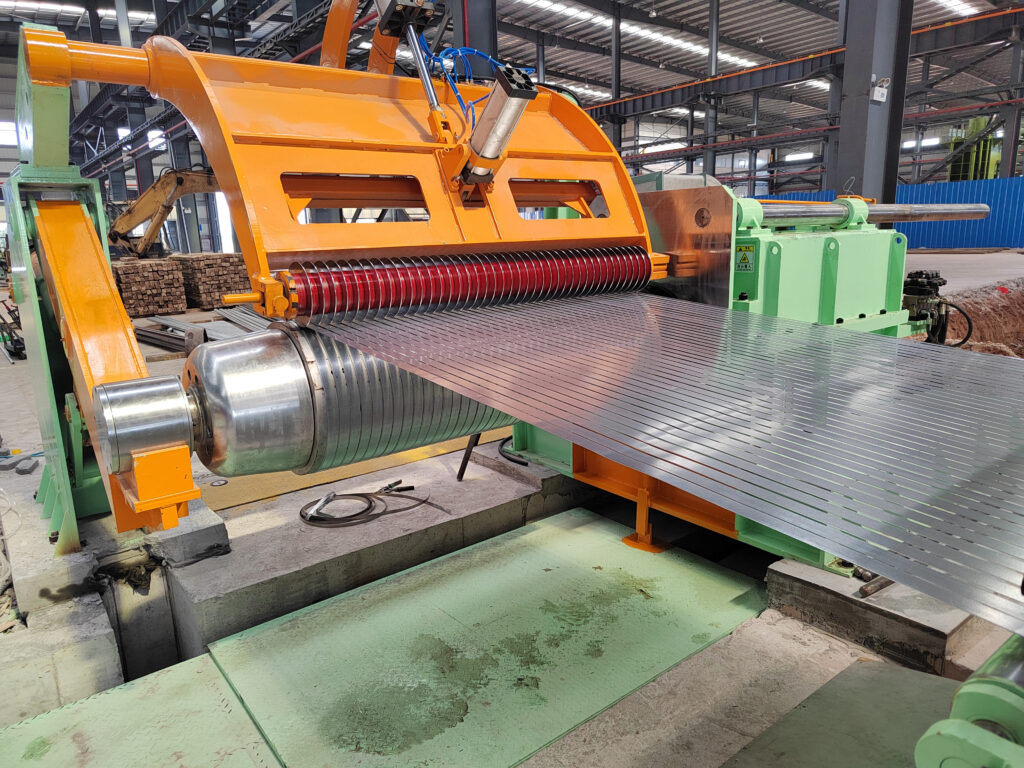
Case Study: Vietnamese Appliance Component Manufacturer
Note: This case study is provided by the manufacturer and has not been independently verified.
A Vietnamese manufacturer of appliance components needed cost-effective coil processing equipment to handle galvanized steel for washing machine and refrigerator parts. The application required reliable processing with adequate flatness for downstream forming operations.
Processing Requirements:
- Processing galvanized steel from 0.6mm to 2.5mm thickness
- Width range from 100mm to 1200mm for various component applications
- Flatness requirements within ±1.5mm for forming operations
- Reliable operation with local technical support availability
Solution Implemented:
- MD-1650 processing line with standard configuration
- 15-roller leveling system with manual adjustment capability
- Basic slitting system with rotary knives
- Standard material handling and coiling systems
Results After 18 Months:
- Consistent processing of galvanized steel with acceptable quality
- Flatness achieved within ±1.2mm across most product widths
- Local staff successfully trained for routine operation and maintenance
- Production capacity met appliance component requirements
- Equipment availability of 86% achieved with preventive maintenance
| System Component | Technical Specification | Application Suitability |
|---|---|---|
| Material Thickness Range | 0.3-12mm | Covers most standard coil processing applications |
| Width Processing | 20-2150mm | Suitable for standard industrial requirements |
| Processing Speed | Up to 150m/min (material dependent) | Adequate for most production volumes |
| Leveling Accuracy | ±0.8mm flatness typical | Suitable for standard tolerance applications |
| Width Tolerance | ±0.2-0.3mm typical | Adequate for most industrial requirements |
2. Bradbury Group
Headquarters: Moundridge, Kansas, USA
Specialization: Roll forming and coil processing equipment with focus on precision and durability
Key Capabilities:
- Advanced roll forming lines
- Cut-to-length systems
- Slitting and rewinding equipment
- Custom automation solutions
3. Fagor Arrasate
Headquarters: Mondragón, Spain
Specialization: Complete metal forming solutions including coil processing lines
Key Capabilities:
- Blanking lines
- Cut-to-length lines
- Slitting lines
- Servo-driven systems
4. Dimeco
Headquarters: Charleroi, Belgium
Specialization: Coil processing and metal forming equipment for automotive industry
Key Capabilities:
- High-speed blanking lines
- Progressive die systems
- Coil handling equipment
- Automation integration
5. Schuler Group
Headquarters: Göppingen, Germany
Specialization: Press technology and coil processing solutions
Key Capabilities:
- Blanking lines
- Cut-to-length systems
- Coil handling systems
- Digital manufacturing solutions
6. ANDRITZ
Headquarters: Graz, Austria
Specialization: Industrial equipment and systems for various industries
Key Capabilities:
- Metal processing lines
- Automation systems
- Process optimization
- Service and maintenance
7. Dallan S.p.A.
Headquarters: Vittorio Veneto, Italy
Specialization: Flexible manufacturing systems for metal processing
Key Capabilities:
- Flexible roll forming lines
- Punching and cutting systems
- Coil processing equipment
- Industry 4.0 solutions
8. Formtek Group
Headquarters: Cleveland, Ohio, USA
Specialization: Metal forming and fabricating equipment
Key Capabilities:
- Slitting lines
- Cut-to-length lines
- Coil handling systems
- Custom solutions
9. Gasparini Industries
Headquarters: San Vendemiano, Italy
Specialization: Sheet metal working machinery
Key Capabilities:
- Press brakes
- Shears
- Coil processing lines
- Automation systems
10. Jouanel Industrie
Headquarters: Saint-Étienne, France
Specialization: Metal processing and forming equipment
Key Capabilities:
- Slitting lines
- Blanking lines
- Coil handling systems
- Custom engineering
Technology & Capability Comparison
Processing Specifications Comparison
| Supplier | Max Thickness | Max Width | Max Speed | Coil Weight |
|---|---|---|---|---|
| Max Domachine | 12mm | 2150mm | Up to 150m/min | 25 tons |
| Bradbury Group | 10mm | 2000mm | 200m/min | 30 tons |
| Fagor Arrasate | 8mm | 1800mm | 180m/min | 25 tons |
| Dimeco | 6mm | 1600mm | 150m/min | 20 tons |
| Schuler Group | 8mm | 1800mm | 160m/min | 25 tons |
Technology Features Comparison
Note: The following comparison is based on manufacturer claims and has not been independently verified. Actual performance may vary based on specific applications and configurations.
| Feature | Max Domachine | Competitors Average |
|---|---|---|
| Automation Level | Advanced automation | Varies by supplier |
| Control System | PLC + HMI | Standard PLC systems |
| Precision | ±0.2-0.3mm typical | ±0.2-0.5mm range |
| Setup Time | 15-30 minutes | 30-60 minutes |
| Energy Efficiency | Standard to above standard | Standard |
Industry Applications & Case Studies
Automotive Industry Applications
The automotive sector represents the largest application segment for coil processing equipment, driven by increasing demand for lightweight materials and precision components. Modern automotive manufacturing requires sophisticated coil processing capabilities to handle advanced high-strength steels and aluminum alloys.
Key Requirements:
- Material Variety: Processing of AHSS, aluminum, and specialty alloys
- Precision Standards: Tight tolerances for safety-critical components
- Production Volume: High-speed processing for mass production
- Quality Control: Comprehensive inspection and traceability systems
Case Study: Automotive Body Panel Production
Note: This case study is provided by the manufacturer and has not been independently verified.
A major automotive manufacturer implemented Max Domachine’s advanced slitting line to process high-strength steel for body panels. Results claimed:
- 40% increase in processing speed
- 60% reduction in material waste
- 99.5% quality consistency
- 18-month ROI payback period
Appliance Manufacturing
Home appliance production requires versatile coil processing equipment capable of handling various materials and thicknesses for different components, from thin decorative panels to structural elements.
Processing Requirements:
- Surface Quality: Premium finish for visible components
- Material Efficiency: Optimized cutting patterns to minimize waste
- Flexibility: Quick changeover between different products
- Cost Effectiveness: Competitive processing costs for consumer products
Case Study: Refrigerator Panel Processing
Note: This case study is provided by the manufacturer and has not been independently verified.
A leading appliance manufacturer upgraded to Max Domachine’s integrated processing line for stainless steel refrigerator panels. Results claimed:
- 50% reduction in setup time
- 25% improvement in surface quality
- 35% increase in material utilization
- 15% reduction in overall production costs
Construction Industry
The construction sector requires robust coil processing equipment for producing roofing materials, siding, and structural components with consistent quality and dimensional accuracy.
Key Applications:
- Roofing Materials: Metal roofing panels and accessories
- Siding Systems: Architectural panels and trim components
- Structural Elements: Framing components and reinforcement materials
- HVAC Components: Ductwork and ventilation system parts
ROI & Productivity Analysis
Investment Considerations
Coil processing equipment represents a significant capital investment, typically ranging from $500,000 to $5 million depending on specifications and automation level. Understanding the return on investment is crucial for making informed purchasing decisions.
Cost Factors:
| Equipment Type | Investment Range | Payback Period | Key Benefits |
|---|---|---|---|
| Basic Slitting Line | $500K – $1M | 2-3 years | Improved material utilization |
| Advanced Processing Line | $1M – $3M | 3-4 years | Higher productivity, quality |
| Fully Automated System | $3M – $5M | 4-5 years | Maximum efficiency, minimal labor |
Productivity Benefits
Modern coil processing equipment delivers significant productivity improvements across multiple operational areas:
- Material Utilization: 15-25% improvement in material yield
- Processing Speed: 30-50% increase in throughput
- Quality Consistency: 90% reduction in defect rates
- Labor Efficiency: 40-60% reduction in direct labor requirements
- Energy Savings: 20-30% reduction in energy consumption per unit
Total Cost of Ownership Analysis
When evaluating coil processing equipment, consider the total cost of ownership over the equipment lifecycle:
Initial Investment (Year 0)
- Equipment purchase price
- Installation and commissioning
- Training and startup costs
- Facility modifications
Operating Costs (Years 1-10)
- Energy consumption
- Maintenance and spare parts
- Labor costs
- Consumables and tooling
Benefits (Years 1-10)
- Increased production capacity
- Improved material utilization
- Reduced labor costs
- Enhanced product quality
- Energy savings
Equipment Selection Guide
Determining Your Requirements
Before selecting coil processing equipment, conduct a thorough analysis of your current and future needs:
Material Specifications
- Material types (stainless steel, carbon steel, aluminum)
- Thickness range requirements
- Width specifications
- Surface quality standards
- Volume requirements
Production Requirements
- Daily/monthly production targets
- Product mix and changeover frequency
- Quality standards and tolerances
- Automation level preferences
- Integration with existing systems
Facility Considerations
- Available floor space
- Power supply capacity
- Crane and material handling capabilities
- Environmental requirements
- Safety and regulatory compliance
Supplier Evaluation Criteria
When evaluating potential suppliers, consider these critical factors:
Technical Capabilities
- Processing range and specifications
- Technology level and innovation
- Customization capabilities
- Quality and precision standards
- Automation and control systems
Business Factors
- Financial stability and reputation
- Global presence and support network
- Delivery timeframes
- Pricing competitiveness
- Warranty and service terms
Support Services
- Technical support availability
- Training programs
- Spare parts availability
- Maintenance services
- Upgrade and modernization options
Frequently Asked Questions
How do I evaluate tension control performance in coil processing equipment?
Tension control is critical for maintaining material quality and preventing defects. Evaluate systems based on their ability to maintain consistent tension across varying coil diameters and material properties. Key technical specifications include:
Response Time: Modern servo-driven systems should respond to tension variations within 50-100 milliseconds. Slower response times can result in material deformation or web breaks.
Tension Accuracy: Look for systems that can maintain tension within ±2% of setpoint across the full operating range. This requires high-resolution load cells and sophisticated control algorithms.
Material Compatibility: Ensure the tension control system can handle your specific material grades. Stainless steel requires different control strategies than aluminum due to differences in elastic modulus and work hardening characteristics.
Integration Capabilities: The tension control system should integrate with upstream and downstream equipment to maintain consistent material flow throughout the entire processing line.
What are the critical factors for achieving consistent edge quality in slitting operations?
Edge quality in slitting operations depends on multiple interrelated factors that must be optimized as a system:
Knife Selection and Maintenance: The choice between rotary, shear, or razor slitting depends on material properties and quality requirements. Rotary knives typically provide the best edge quality for thin materials, while shear cutting works better for thicker sections. Knife wear monitoring and replacement schedules are critical for maintaining consistent quality.
Cutting Parameters: Cutting speed, knife overlap, and cutting force must be optimized for each material grade and thickness. These parameters often require adjustment based on material lot variations and environmental conditions.
Material Support: Proper material support before and after the cutting point prevents material deflection that can cause edge defects. This includes appropriate strip separators, edge guides, and tension control.
Vibration Control: Cutting forces can induce vibrations that affect edge quality. Modern slitting systems incorporate vibration damping and rigid machine construction to minimize these effects.
How do I calculate the total cost of ownership for coil processing equipment?
Total cost of ownership extends far beyond the initial purchase price and should include all costs over the equipment’s operational life:
Initial Investment (Year 0):
- Equipment purchase price (typically 60-70% of total)
- Installation and commissioning (15-20%)
- Training and startup costs (5-10%)
- Facility modifications and utilities (5-15%)
Operating Costs (Annual):
- Energy consumption (varies by usage, typically $20,000-50,000 annually)
- Maintenance labor and parts (3-5% of equipment value annually)
- Knife replacement and tooling (material dependent, $10,000-30,000 annually)
- Insurance and compliance costs
Productivity Benefits:
- Increased throughput compared to existing equipment
- Improved material utilization and reduced waste
- Labor cost reduction through automation
- Quality improvements reducing customer complaints and rework
Hidden Costs to Consider:
- Downtime costs during installation and commissioning
- Learning curve productivity losses
- Spare parts inventory requirements
- Potential facility upgrades for power, compressed air, or space
Selecting the Right Coil Processing Partner
In 2025, selecting the right coil processing equipment supplier is a strategic decision with long-lasting operational impact. Beyond advanced technology, success hinges on choosing a partner offering comprehensive lifecycle support, from seamless integration to proactive maintenance. Leading suppliers exhibit deep expertise in addressing specific material challenges—such as varying coil tensile properties and high-speed processing demands—as demonstrated by real-world implementations like tier-1 automotive manufacturers optimizing dual-phase steel slitting with MaxDo’s MD-1650 line. Their robust project management and installation capabilities minimize production downtime, ensuring smooth commissioning even in complex multi-system environments.
Moreover, long-term value derives from suppliers committed to continuous improvement, offering scalable, modular designs and standardized communication protocols that future-proof your investment against evolving manufacturing needs. This includes responsive technical support, thorough operator training, and steady availability of critical spare parts, all vital for maintaining peak equipment performance under high-throughput conditions. As the coil processing industry advances, these partnerships transcend transactional vendor relationships, becoming technical alliances that empower manufacturers to sustain competitive advantage through innovation, reliability, and operational excellence. Choosing the right supplier means securing not just equipment, but a resilient foundation for growth and efficiency in the dynamic manufacturing landscape of 2025 and beyond.
Important Disclaimers
Information Accuracy: This analysis is based on publicly available information and industry experience as of August 2025. Company information, technical specifications, and performance claims should be verified through direct consultation with suppliers and reference customer contacts.




